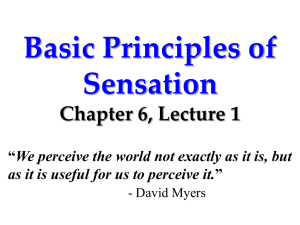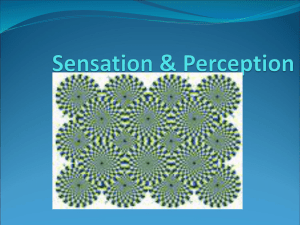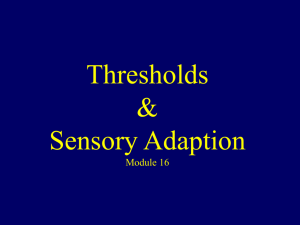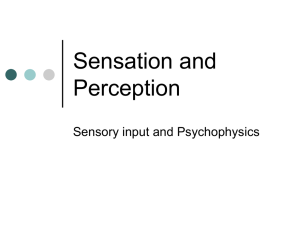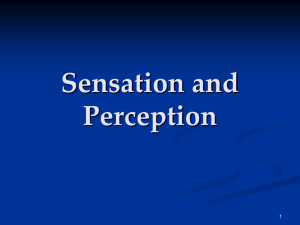Absolute Threshold “The pain of the mind is worse than the pain of
advertisement
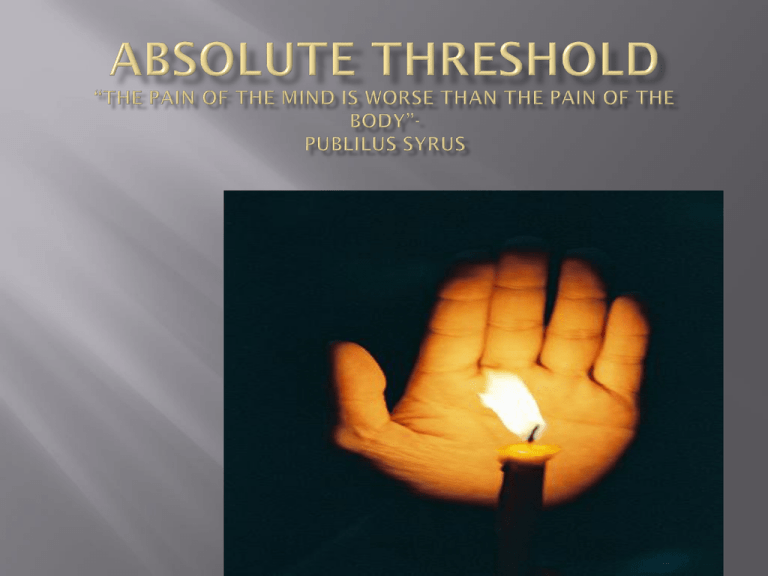
Human Sense Vision Absolute Threshold is Equivalent to: Hearing The tick of a watch under quiet conditions at 20 feet 1 teaspoon of sugar in 2 gallons of water Taste A candle flame seen at 30 miles on a clear night Smell 1 drop of perfume diffused into the entire volume of air in a 6 room apartment Touch The wing of a fly falling on your cheek from a distance of 1 centimeter Subliminal Stimuli: fall below absolute threshold and thus are not usually detected Supraliminal Stimuli: are usually detected because they are above absolute threshold A mathematical model that can explain why a person does or does not detect a stimulus. This is attributed to the following: Sensitivity: the ability to detect a stimulus Example: In the chapter on sensation, you learned how age can affect the ability of the three bones in the inner ear to conduct sound. A person with a decrease in bone conductivity would be less sensitive to external auditory stimuli. 1. REMEMBER: Sensitivity reflects physical changes in the nervous system, sensory system, or stimulus not the motivation of the person 2. Response Criterion: A person’s willingness or reluctance to respond to a stimulus. A bias for either is created by motivation and expectancy Example: Dr. Charles, a cancer specialist, sees cancer patients who have been referred to him by other physicians. Therefore, when he looks at patients' x-rays for the first time, he expects to perceive cancerous shadows. Therefore, he is likely to perceive even faint shadows as cancer when, in reality, none may exist. •The smallest difference between stimuli that we can detect –How small is the difference?? •Determined by two factors: 1. How much stimuli there is to begin with: the weaker the stimuli are, the easier it is to detect small differences between them. Example: if you are comparing the weight of two envelopes, you will be able to detect a difference of as little as a fraction of one ounce. 2. Which sense is being stimulated *** the relationship between the two Weber’s Law States: that the smallest detectable difference in stimulus energy is a constant fraction of the intensity of the stimulus. •Weber’s Constant or Weber’s Fraction is given the symbol KK is different for each sense •Weber’s Law says: that JND=KI(amount of stimulus) •Example: the value of K for weight is .02. If an object weighs 25 lbs(I), the JND is (.02x25)==.o5 or half a pound—so in order to feel a difference you would have to add or remove half a pound. Weber’s Fraction (K) for Different Stimuli Stimulus K Pitch .003 Brightness .017 Weight .02 Odor .05 Loudness .10 Pressure on Skin .14 Saltiness of taste .20 Gustav Fechner used Weber’s Law to study the relationship between the physical magnitude of a stimulus and its perceived magnitude. He reasoned that the JND gets larger as the stimulus magnitude increases. Example: when bench pressing 50lbs you are more likely to notice a 5lb increase than you would if you were benching 100lbs

